height adjustment AUDI A4 SEDAN 2013 Owners Manual
[x] Cancel search | Manufacturer: AUDI, Model Year: 2013, Model line: A4 SEDAN, Model: AUDI A4 SEDAN 2013Pages: 294, PDF Size: 73.71 MB
Page 56 of 294
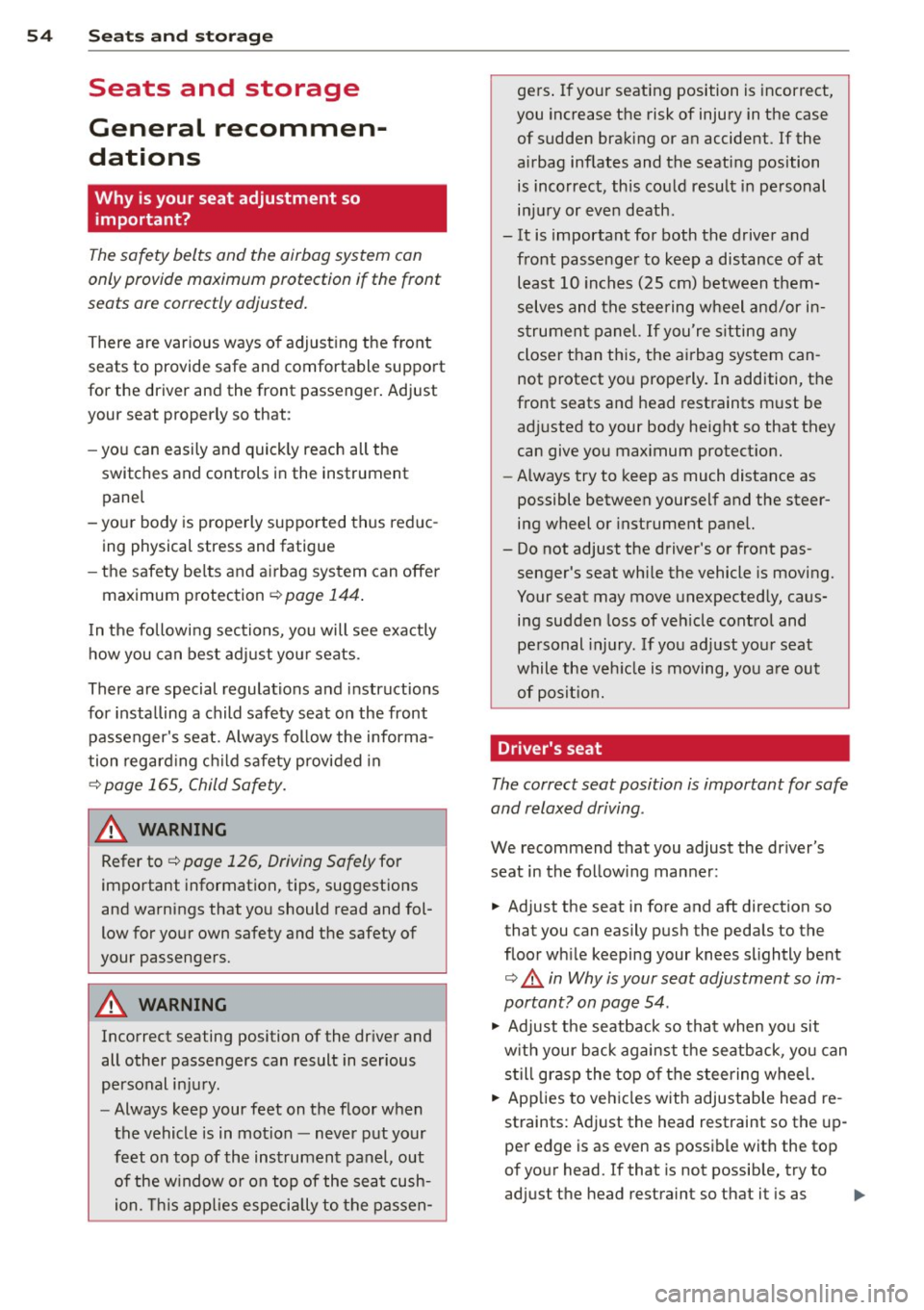
54 Seat s a nd s tor ag e
Seats and storage
General recommen
dations
Why is your seat adjustment so
important?
The safety belts and the airbag system can
only provide maximum protection if the front
seats are correctly adjusted.
There are various ways of adjust ing the front
seats to provide safe and comfortable support
for the driver and the front passenger . Adjust
your seat properly so that :
- you can easily and quick ly reach all the
switches and controls in the instrument
panel
-your body is prope rly supported thus reduc
ing physical stress and fatigue
- the safety be lts and airbag system can offer
maximum protection ¢
page 144.
In the following sec tions, you will see exactly
how you can best adjust you r seats .
There are special regulations and instructions
for insta lling a child safety seat on the front
passenger's seat. Always follow the informa
tion rega rd ing child safety provided in
G page 165, Child Safety.
WARNING
Refer to G page 126, Driving Safely for
important information, tips, suggestions
and warnings that you should read and fol
low for your own safety and the safety of
your passengers.
A WARNING
, -
Incorrect seating position of the dr iver and
all other passengers can result in serious
personal inj ury .
- Always keep your feet on the f loor when
the vehicle is in motion -never put your
feet on top of the instrument panel, out of the w indow or on top of the seat cush
ion. This app lies especially to the passen- gers
. If your seating position is incorrect,
you increase the risk of injury in the case of sudden braking or an accident. If the
airbag inflates and the seating position is incorrect, this could result in pe rsonal
in ju ry or even death.
- It is important for both the driver and front passenge r to keep a distance of at
least 10 inches (25 cm) between them
selves and the steering wheel and/or in
strumen t panel.
If you're s itting any
closer than th is, the a irbag system can
not protect you properly. In addition, the
front seats and head restraints m ust be
adj usted to your body height so that they
can give you max imum protect ion.
- Always try to keep as much distance as
possible between yourself and the steer
ing wheel or instrument panel.
- Do not adjust the driver's or front pas
senger's seat while the vehicle is moving.
Your seat may move unexpectedly , caus
ing sudden loss of veh icle control and
personal injury. If you adjust you r seat
while the veh icle is moving, yo u are out
of pos it ion.
Driver's seat
The correct seat position is important for safe
and relaxed driving .
We recommend that you adjust the dr iver's
seat in the follow ing manner:
.. Adjust the seat in fore and aft direction so
that you can easily push the pedals to the
floor wh ile keeping your knees slightly bent
G &. in Why is your seat adjustment so im
portant? on page 54 .
.,. Adjust the seatback so that when you sit
w ith your back against t he seatback, you can
s till grasp the top of the steering whee l.
.. Applies to veh icles with adjustable head re
straints: Adjust the head restraint so the up
per edge is as even as possible with the top
of yo ur head. If that is not possib le, try to
adjust the head restraint so that it is as .,.
Page 59 of 294
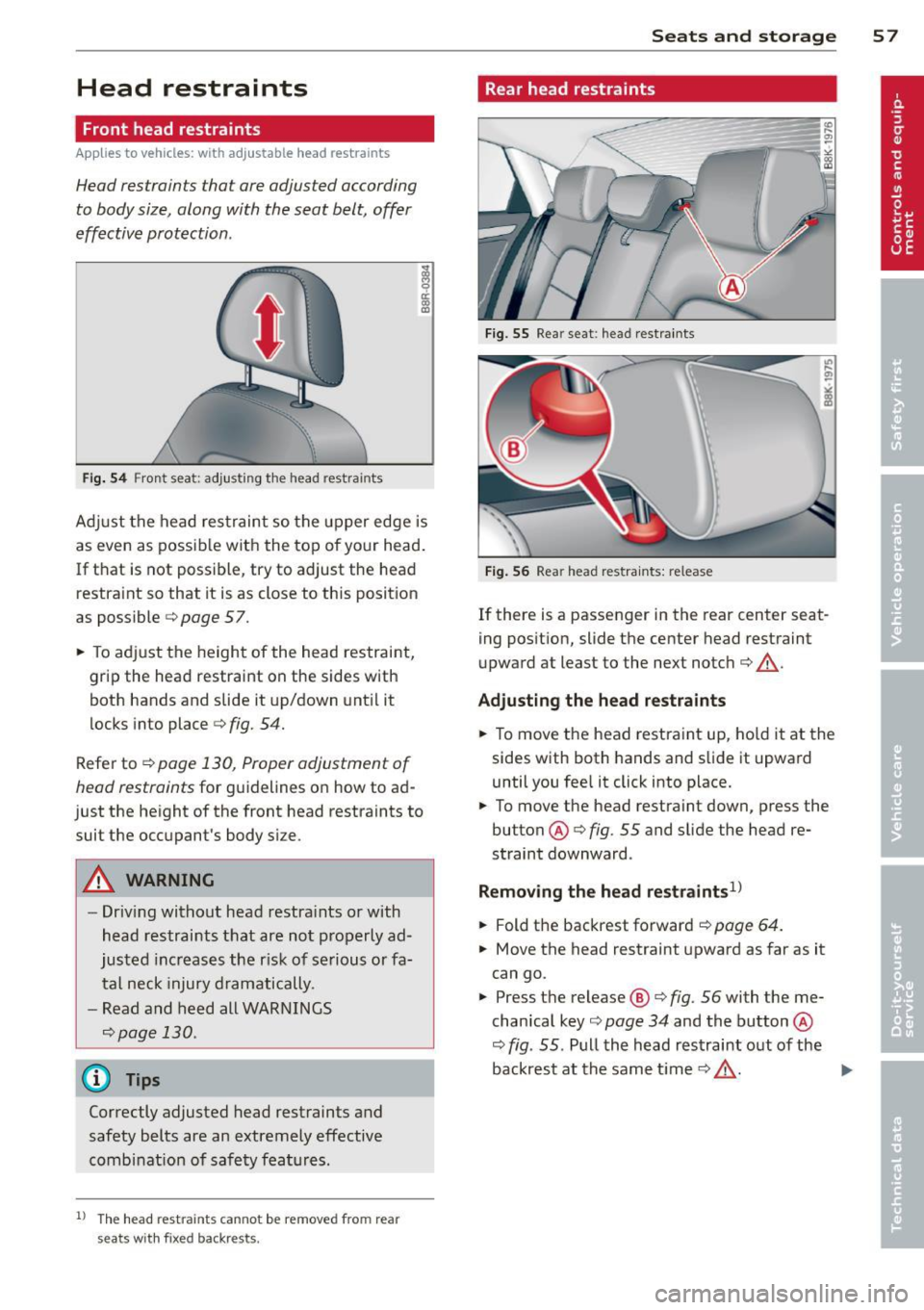
Head restraints
Front head restraints
Applies to vehicles: with adj ustable head restraints
Head restraints that ore adjusted according
to body size, along with the seat belt , offer
effective protection .
Fig. 54 Fron t seat: adjusting the head rest ra in ts
Ad just the head restraint so the upper edge is
as even as possible with the top of your head.
If that is not poss ible, try to adjust the head
restraint so that it is as close to this position
as possible
¢ page 57.
~ To adjust the height of the head restraint,
grip the head restraint on the sides with
both hands and slide it up/down until it
locks into place
¢fig. 54.
Refer to ¢ page 130, Proper adjustment of
head restraints
for guidelines on how to ad
just the height of the front head restraints to
suit the occupant's body size .
A WARNING
-Driving without head restra ints or with
head restraints that are not properly ad
justed increases the r isk of serious or fa
tal neck injury dramatically.
- Read and heed all WARNINGS
¢page 130.
@ Tips
Correctly adjusted head restraints and
safety belts are an extremely effective
combinat ion of safety features .
l) The head restr aints cann ot be re move d fro m rear
se ats with fixe d backr ests.
-
Seats and storage 57
Rear head restraints
Fig. 55 Rea r seat : head restraints
Fig. 56 Rear head restraints: release
If there is a passenger in the rear center seat
ing position, slide the center head restraint
upward at least to the next notch¢&_.
Adjusting the head restraints
~ To move the head restraint up, hold it at the
sides with both hands and slide it upward
until you feel it click into place.
~ To move the head restraint down, press the
button @¢
fig. 55 and slide the head re
straint downward .
Removing the head restraints1>
~ Fold the backrest forward ¢ page 64.
~ Move the head restraint upward as far as it
can go.
~ Press the release@¢ fig. 56 with the me
chanical key¢
page 34 and the button @
¢
fig . 55 . Pull the head restraint out of the
backrest at the same time¢&_ .
~
Page 142 of 294
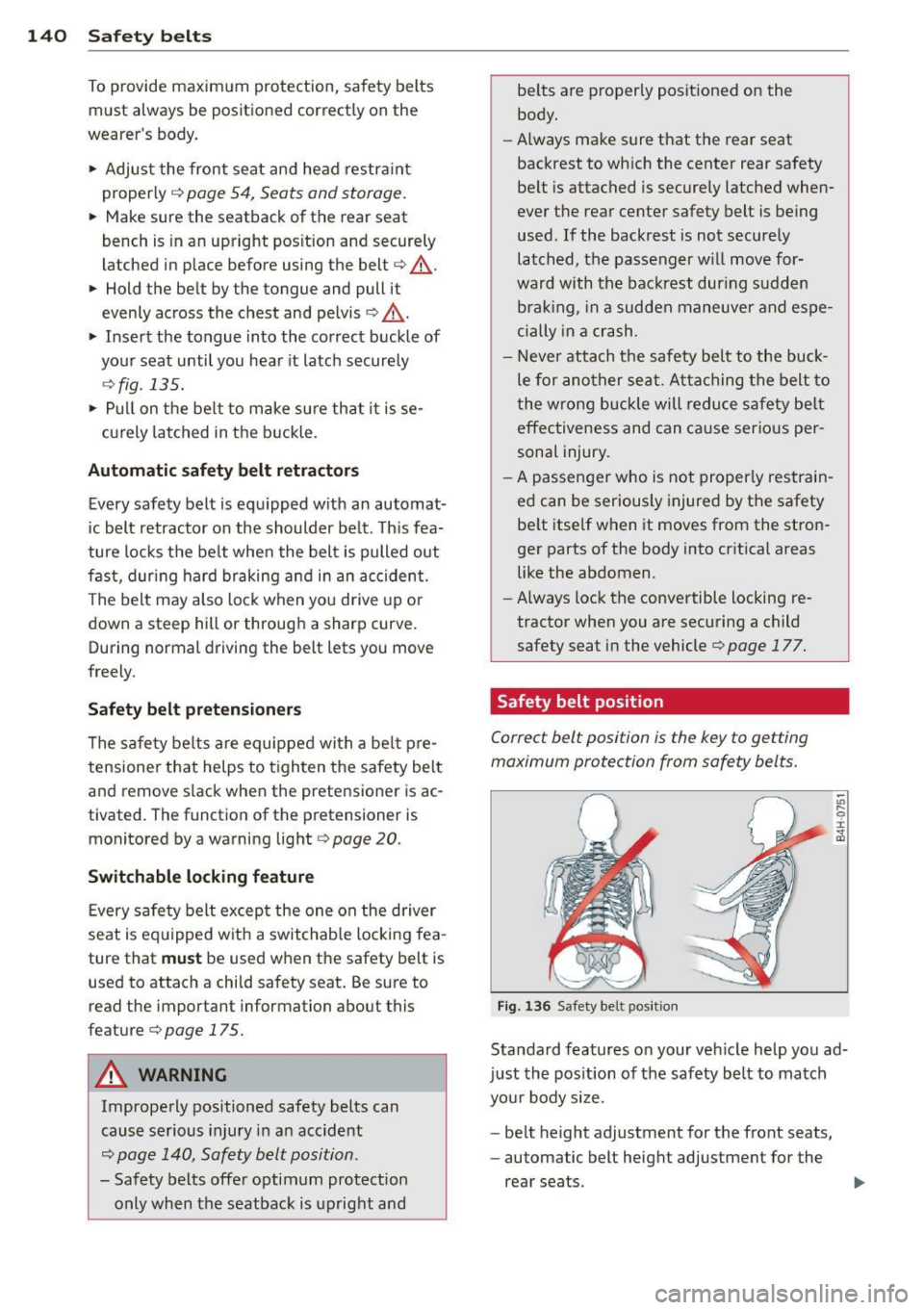
140 Safet y belts
To provide maximum protection, sa fety belts
must always be positioned correctly on the
wearer 's body .
.,. Adjus t the front seat and head restra int
properly ¢
page 54, Seats and storage .
.,. Make sure the seatback of the rear seat
bench is in an upright pos ition and securely
latched in place befo re using the belt¢.&, .
.,. Hold the belt by the tongue and pull it
evenly across the chest and pelvis
c:> .&, .
.,. Insert the tongue into the co rrect buckle of
you r seat until you hea r it latch securely
¢ fig . 135.
.,. Pull on the be lt to make sure that it is se-
curely latched in the b uckle .
Automatic safety belt retractors
Every safety belt is equipped w ith an automat
ic belt retractor on the shoulder be lt . T his fea
ture locks the be lt when the belt is pulled out
fast, dur ing hard bra king and in an acci dent.
The belt may also lock when yo u drive up or
down a steep hill or through a sharp curve. During normal driving the belt lets you move
freely .
Safety belt pretensioners
The sa fe ty belts are equippe d wi th a be lt pre
tensioner that helps to t igh ten the safety bel t
and remove s lack when the pretensioner is ac
tivated. The function of the pretensioner is
monitored by a warning light¢
page 20 .
Switchable locking feature
Every sa fe ty belt ex cep t the one on the dr iver
seat is eq uipped w it h a switchable locking fea
ture that
mu st be used w hen the safety belt is
used to attach a child safety seat . Be sure to
read the important inf ormation about this
feature
¢ page 175.
A WARNING
Imprope rly positioned safety belts can
cause serious injury in an accident
¢ page 140, Safety belt position .
- Safety belts offe r optimum protection
only when the seatback is up right and
-
be lts are properly posit ioned on the
body.
- Always make sure that the rear seat
backrest to wh ich the center rear safety
be lt is attached is securely latched when
ever the rea r center safety belt is being
used. If the backrest is not secure ly
latched, t he passenger w ill move for
ward with the ba ckr est dur ing sudd en
bra king, in a sudden maneuver and es pe
ci ally in a cra sh .
- Neve r at tach t he safety be lt to t he buck
le for an other se at. At taching the belt to
the wrong buckle will redu ce s afe ty be lt
effec tiveness and can cause serio us per
sonal injury.
- A passenger who is not properly restrain
ed can be seriously injured by the safety
be lt itself w hen it moves from the stro n
ger parts of the body into cr itical areas
like the abdomen .
- Always loc k the convertible locking re
tractor when you are secu ring a child
safety seat in the vehicle
c:> page 177 .
Safety belt position
Correct belt position is the key to gett ing
maximum protection from safety belts.
Fig . 1 36 Safe ty bel t pos it ion
Standard features on your veh icle help you ad
j u st the pos ition of the safety be lt to match
you r body si ze.
- be lt height adjustment for the front seats,
- automatic belt height adjustment for the
rear seats .
Page 175 of 294
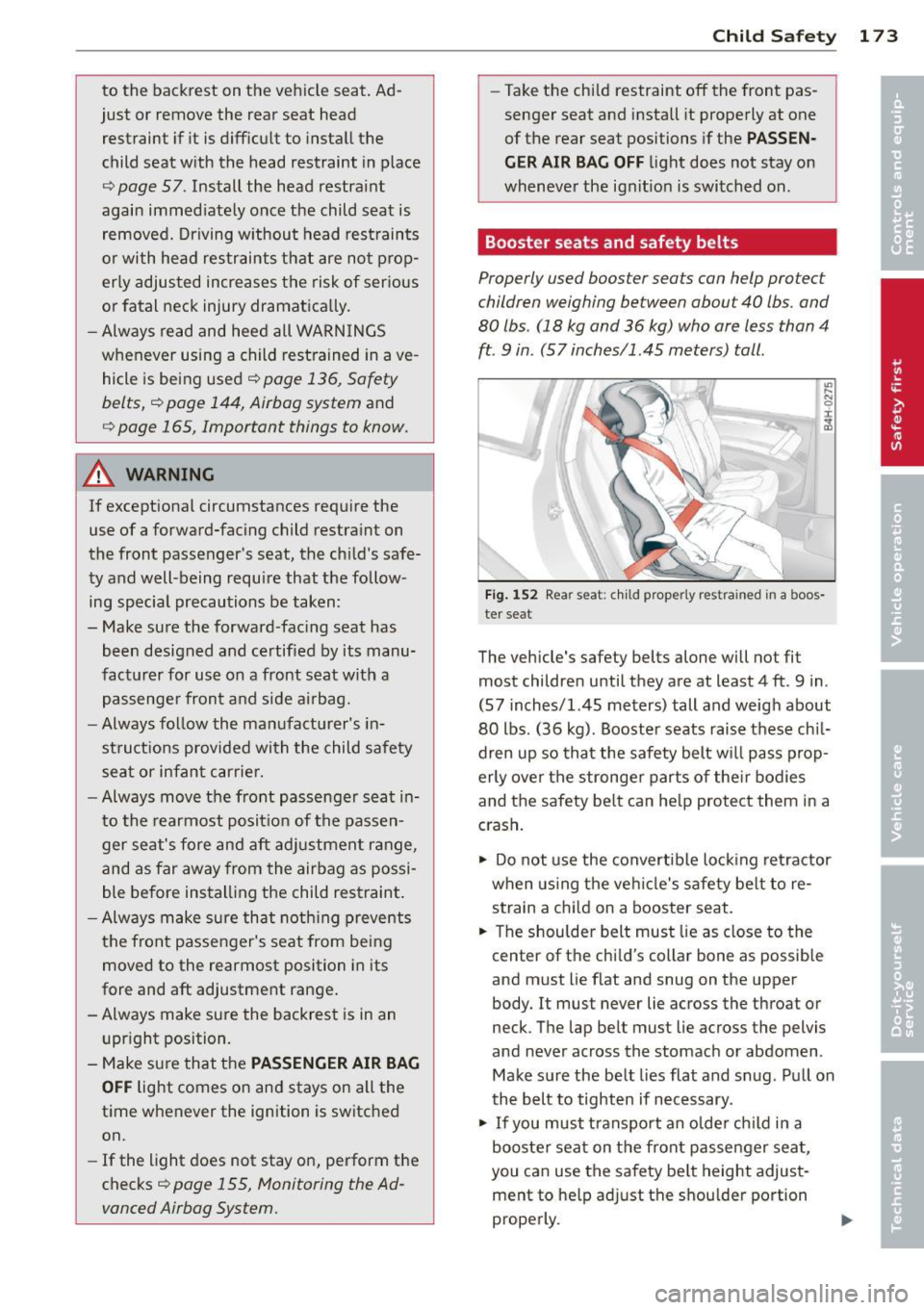
to the backrest on the vehicle seat. Ad
just or remove the rear seat head restraint if it is diff icult to install the
child seat w ith the head restraint in place
¢ page 57. Install the head restraint
again immed iate ly once the child seat is
removed. Driving without head rest raints
o r with he ad restraints that are not prop
erly adjusted increases the risk of serious
or fatal neck injury dramatically.
- Always read and heed all WARNINGS
whenever using a child rest rained in ave
hicle is being used
¢page 136, Safety
belts,
¢ page 144, Airbag system and
¢ page 165, Important things to know.
A WARNING
If except ional circumstances requ ire the
use of a forward-facing child restra int on
the front passenger's seat, the ch ild's safe
ty and well-being require that the follow
ing special precautions be taken:
- Make sure the forward-fac ing seat has
been designed and certified by its manu
factur er for use on a front seat with a
passenge r fron t and side airbag.
- Always follow the manufacturer's in
st ruct ions provided with the child sa fety
sea t or infan t carrier.
- Always mov e the front passenge r seat in
to the rearmost posit ion of the passen
ger seat's fore and aft ad justment r ange,
and as far away from the airbag as possi
ble before instal ling the child restraint.
- Always make sure that noth ing prevents
the front passenger's seat from bei ng
moved to the rearmost position in its
fore and aft adjustment range .
- Always make sure the backrest is in an upright position.
- Make su re that the
PASSENGER AIR BAG
OFF
light comes on and stays on all the
time whenever the ignition is switched
on.
- If the light does not stay on, perform the
checks
¢ page 155, Monitoring the Ad
vanced Airbag System.
-
Child S afety 173
- Take the chi ld restraint
off the front pas
senger seat and install it properly at one
of the rear seat positions if the
PASSEN
GER AIR BA G OF F
light does not stay on
whenever the ignit ion is switched on.
Booster seats and safety belts
Properly used booster seats con help protect
children weighing between about 40 lbs. and
80 lbs . (18 kg and 36 kg) who are less than 4
ft. 9 in . (57 inches/1 .45 meters) tall.
In .... N 0 ±
~
Fig . 152 Rear seat: ch ild properly res trained in a boos
ter seat
The vehicle's safety belts alone will not fit most children until they are at least 4
ft. 9 in .
(57 inches/1.45 me ters) tall and weigh about
80 lbs . (36 kg) . Booster seats raise these chi l
dren up so tha t the safety belt w ill pass p rop
erly over the stronger parts of the ir bodies
and the safety be lt can he lp protect them in a
crash.
.,. Do not use the conver tible locking ret ra ctor
when using the ve hicl e's s afety be lt to re
s train a ch ild on a booster seat.
... The shoulder belt must lie as close to the
center of the ch ild's collar bone as possible
and must lie flat and snug on the upper
body. It must never lie across the throat or
neck . The lap belt must lie across the pelvis
and never across the stomach or abdomen .
Make s ure the belt lies flat and snug. Pull on
th e belt to tighten if necessary.
.,. If you must transport an o lder ch ild in a
booster seat on the front passenger sea t,
you can use the safety be lt height adjust
ment to he lp ad just the shou lder portion
properly.
Page 288 of 294
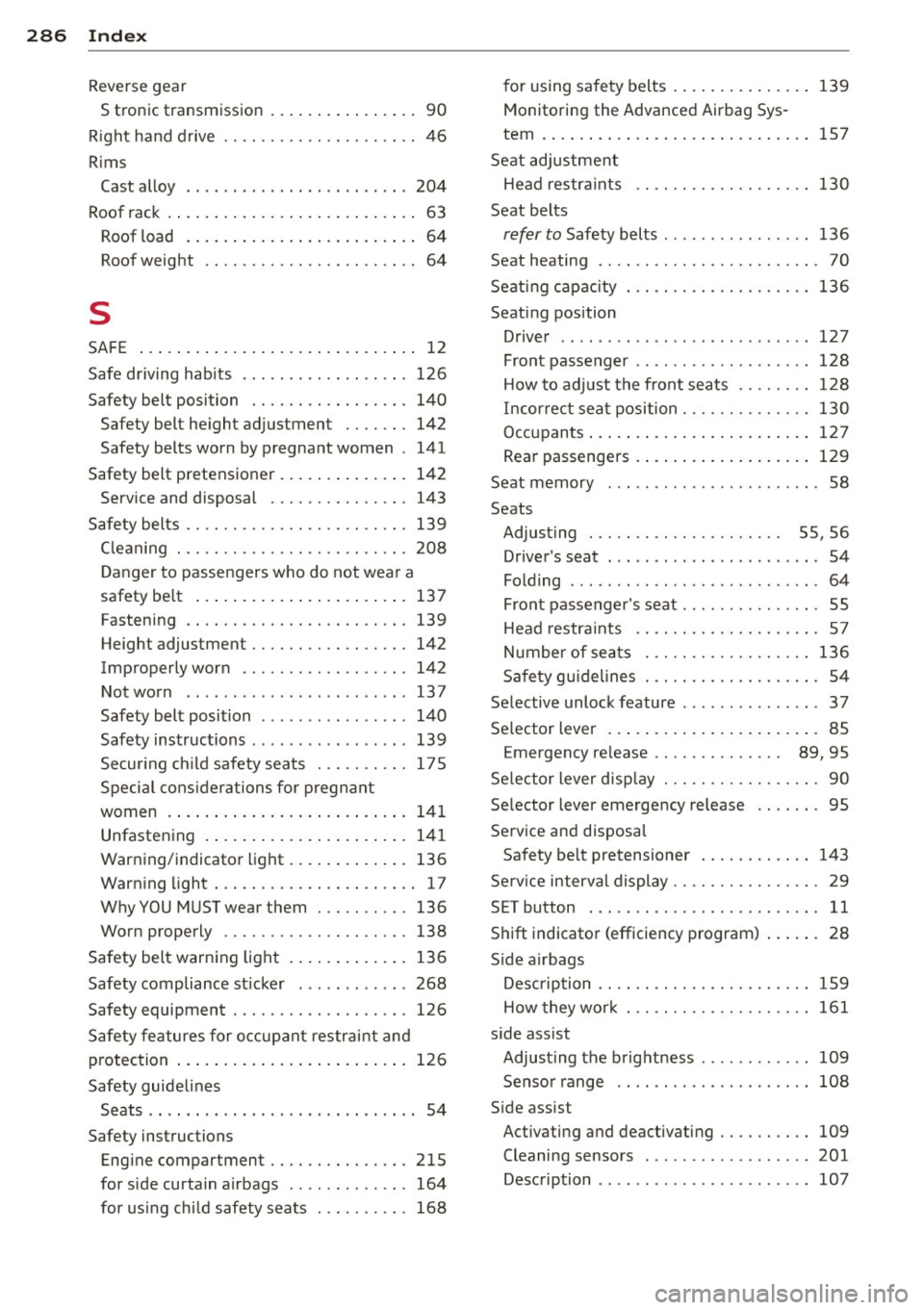
286 Index
Reverse gear S tronic transmission . ... .. .. ... ... .. 90
R ight hand d rive ........... .... .... .. 46
R ims
Cast alloy .. ... . ...... ... .. .. .. .. . 204
Roof rac k . . . . . . . . . . . . . . . . . . . . . . . . . . . 63
Roof load . . . . . . . . . . . . . . . . . . . . . . . . . 64
Roof weight . . . . . . . . . . . . . . . . . . . . . . . 64
s
SA FE ..... .. ... .. ..... ... .. .. .... .. 12
Safe driving hab its ...... ... .. .. .. .. . 126
Safety belt position . . . . . . . . . . . . . . . . . 140
Safety belt he ight adjustment .. .... . 142
Safety belts worn by pregnant women . 141
Safety belt pretensioner ... .. .. .. .... . 142
Service and disposal . . . . . . . . . . . . . . . 143
Safety belts .... ........... .. .. .... . 139
C leaning . .. ............. .... .. .. . 208
D anger to passengers who do not wea r a
safety be lt . . . . . . . . . . . . . . . . . . . . . . . 13 7
Fastening .... ........... .. .. .... . 139
Height adjustment ........ .. .. .. .. . 142
Improperly worn . . . . . . . . . . . . . . . . . . 142
Not worn .. .................. .... 137
Safety belt position ........ ... .. .. . 140
Safety instructions . . . . . . . . . . . . . . . . . 139
Secur ing c hild safety sea ts . .. .. .. ... 175
Speci al consider ations fo r pregnant
women . ... .. .. ...... ... .. .. .... . 141
Unfasten ing . .. .. ..... ... .. .. .... . 141
Warning/ indicato r light . ... .. .. .. .. . 136
Warn ing light . ........... .. .. .... .. 17
WhyYOU M USTwearthem . .. .. .. ... 136
Worn properly ............. .. .... . 138
Safety belt warning light . ... .. .. .... . 13 6
Safety compliance st icker . ...... .. .. . 268
Safety equipment ............ .. .... . 126
Safety fe atures for o ccup ant restra int and
p rotec tion ... ... .. ..... ... .. .. .... . 12 6
Safety guidel ines
Seats .. .. .. ........ ..... .. ........ S4
Safety instructions Eng ine compartment ...... .. .. .. .. . 215
for side curtain a irbags .. .. .. .. .. .. . 164
for us ing chi ld safety seats ..... .. ... 168 f
o r using sa fe ty belts . .. ..... ... .. .. 139
Monito ring the Advanced Airbag Sys-
tem . ... .. .. .. .. .. ... .. ..... ... .. 157
Seat adjustment He ad restra ints .. ............. .... 130
Seat belts
refer to Safety belts ............... . 136
Seat heating ...... ............. .... . 70
Se ating c apac ity . .. ... .......... .. .. 136
Seating pos ition
D rive r ... ... .. .. .. ... ... ... .. .. .. 127
Front passeng er .. .......... ...... . 128
How to ad just the fron t seats .. .. .. .. 1 28
Incor re ct sea t position .......... .. .. 130
Occ upan ts ..... .. ... .. ..... ... .. .. 12 7
Rear passengers . .... .. ..... .... . .. 129
Seat memory . . . . . . . . . . . . . . . . . . . . . . . 58
Seats Adjusting . . . . . . . . . . . . . . . . . . . . . 5S, 56
Driver's seat . . . . . . . . . . . . . . . . . . . . . . . 54
Folding ....... .. .. ... ....... ... .. . 64
Front passenger's seat . . . . . . . . . . . . . . . 5S
Head restra ints .. ... .......... .. .. . 57
N umber of sea ts . ............. .. .. 136
Sa fe ty g uid elines ................ .. . 54
Se lective unlock feature . . . . . . . . . . . . . . . 3 7
Se lector lever ..... .. ... ..... ... .. .. . 8S
Emergency re lease . . . . . . . . . . . . . . 89, 9S
Se lector lever d isp lay . ........... .. .. . 90
Se lector lever emergency release ...... . 9S
Se rvice and disposa l
Safety be lt pretensioner . . . . . . . . . . . . 143
Se rv ice interv al d is play . . . . . . . . . . . . . . . . 29
SET button . . . . . . . . . . . . . . . . . . . . . . . . . 11
S hi ft indicato r (efficiency program) ... .. . 28
S ide a irbags
Des cription ...... ............. .... 159
How they wor k ... ............. .... 161
s ide ass ist
Adjus ting the b rightness . ........... 109
Senso r range .. .. ................ . 108
S ide assist
Activati ng and deactivating .... .. .. .. 109
Cleaning sensors .... .. .. ... ..... .. 201
Desc ription .. .. .. .......... ... ... . 107